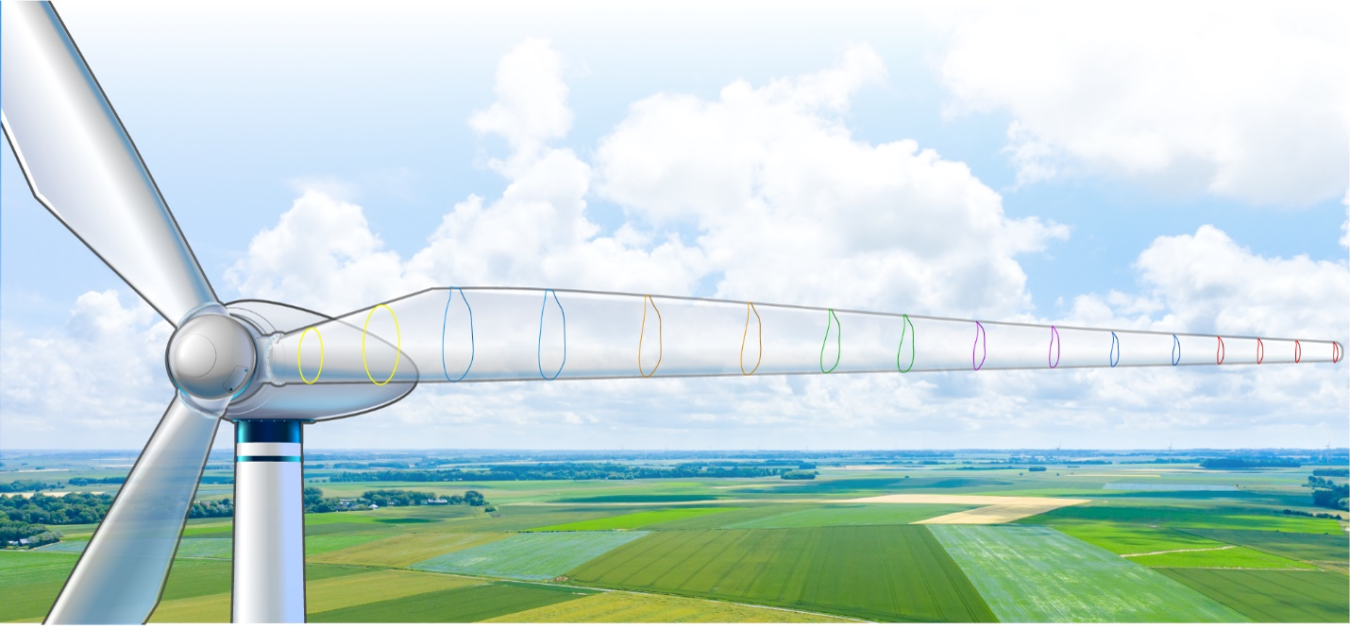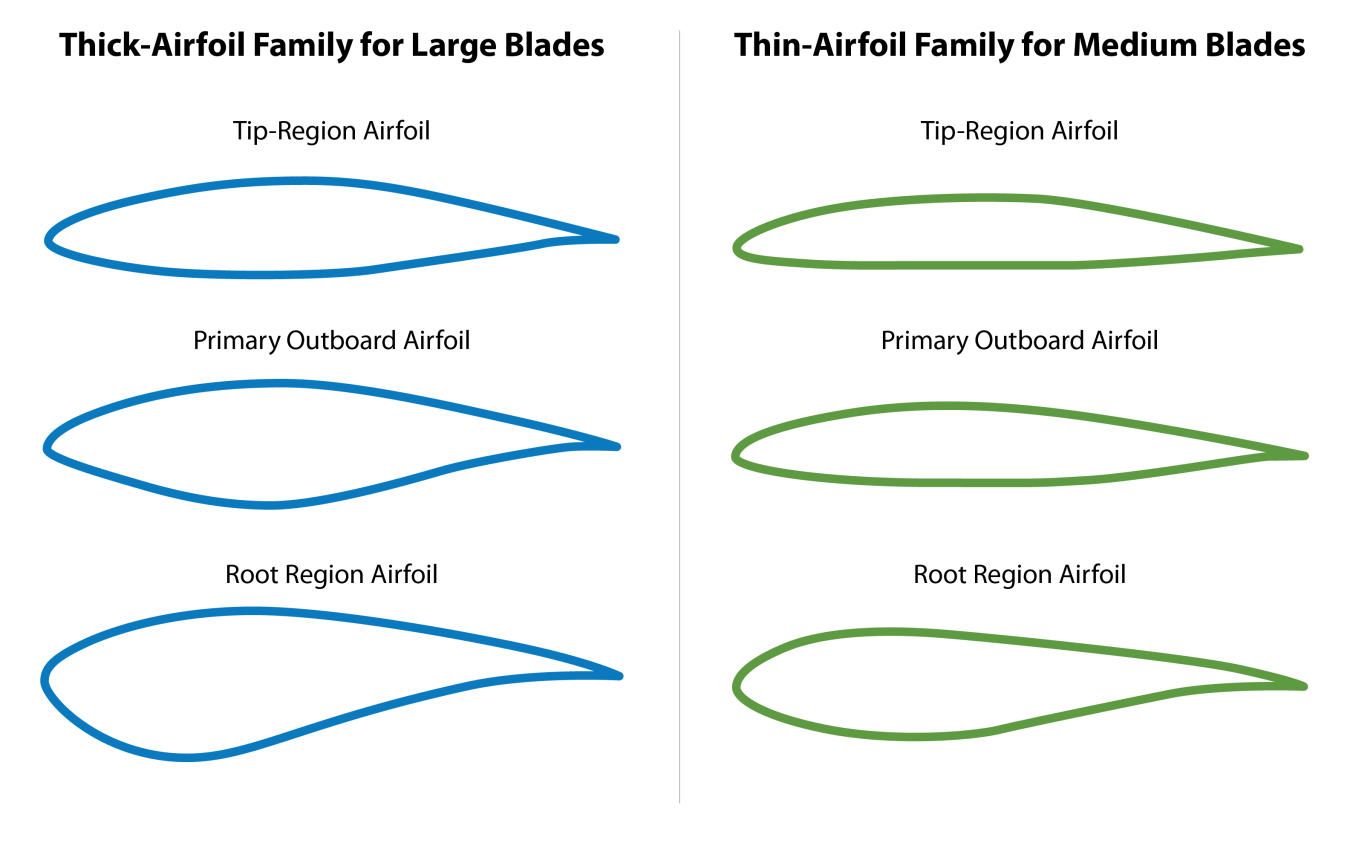Airfoils are the foundation of turbine blade designs. Generating lift and drag when they move through the air, airfoils play a key role in improving the aerodynamic performance and structural durability of a turbine’s blades.
Wind Energy Technologies Office
May 10, 2023Airfoils, the cross-sectional shape of wind turbine blades, are the foundation of turbine blade designs. Generating lift and drag when they move through the air, airfoils play a key role in improving the aerodynamic performance and structural durability of a turbine’s blades.

Airfoils in wind turbines impact the aerodynamic features and structural integrity of a turbine blade.
Airfoils have come a long way since the early days of the wind energy industry. In the 1970s, designers selected shapes for their wind turbine blades from a library of pre-World War II standard airfoil shapes designed for aircraft wings, which was compiled by the National Advisory Committee for Aeronautics, the precursor of the National Aeronautics and Space Administration.
These early wind turbine blade designers focused on major blade features, such as twist and taper to optimize aerodynamic performance, increasing speed and efficiency while reducing drag. However, in the 1980s and 1990s, engineers found that wasn’t enough, tracing in-field performance shortcomings back to airfoil performance.
For instance, engineers noticed that the surface of the blade’s leading edge (the front edge that first contacts air) became more rough over time. This was because of soiling, which results from the buildup of dirt and bugs (like a car windshield without wipers), as well as small-scale damage from general wear and tear. In the 1980s on California’s early wind farms (Altamont Pass Wind Farm and Palm Springs Wind Farm), soiling dropped turbine power production as much as 30% until technicians washed the blades, which added a significant labor burden during the windy—and therefore more profitable—seasons.
Wind gusts put additional pressure on blades, leading to loads (or forces) that are higher than predicted. This causes the blades to stall or slow down their rotation. This, in turn, reduces the efficiency and power production of the wind turbine.
It became clear to researchers at the National Renewable Energy Laboratory (NREL, then known as the Solar Energy Research Institute) that achieving better, more robust performance would require new airfoils tailored specifically for wind turbine applications. In 1984, with funding from the U.S. Department of Energy (DOE), NREL researchers engaged with Airfoils Inc., a small firm focused on airfoil design, to help address the problems.
Reshaping Blades Improved Wind Turbine Performance
The DOE-supported airfoil design effort aimed to:
- Reduce the effect leading-edge soiling had on airfoil performance.
- Improve the aerodynamic performance of the airfoils.
NREL and Airfoils Inc. used both experimental and computational methods in the design process. The experimental method validated clean and soiled versions of the new airfoil designs. Testing at the Delft University low-turbulence wind tunnel in the Netherlands highlighted where the models were inaccurate and in need of improvement. Digitally, researchers created two-dimensional and three-dimensional airfoil designs to simulate potential improvements in functionality.
The experimental measurements and design work informed researchers that:
- Airfoil leading edges could be tailored to be less sensitive to soiling.
- The parts of the blade closer to the tip produce most of the power. In these areas, the airfoils should be as thin as structurally possible to increase aerodynamic efficiency and resistance to soiling.
- A design improvement in the blade root coincides with improved turbine performance in the face of soiling and roughness.
These findings made it clear that new, customized airfoils were needed for each section along the wind turbine blade.
All in the (Airfoil) Family
The result of this research was the first “airfoil family” for wind turbines. These families prioritized the design aspects of airfoils to address aerodynamic and structural requirements.
The DOE-funded effort created a total of seven airfoil families that were validated and published in a series of reports and patents through the mid-1990s. Combined, they set the standard for efficiency in wind turbine blade design.

Two examples of NREL-developed airfoil “families” customized for wind turbine aerodynamics and needs. Source: NREL. 1998. Revised 2000. Advanced Airfoils for Wind Turbines. Washington, D.C.: U.S. Department of Energy. DOE/GO-10098-488. https://www.nrel.gov/docs/fy00osti/23696.pdf.
Standardized Designs Reaped Awards
The broader wind energy industry quickly realized the benefits of the NREL wind turbine airfoil families. Soiling didn’t affect aerodynamic performance and better-matched load requirements. Annual energy production increased to 10%–35% over the once-standard airfoils from the 1970s.
These results earned the work a prestigious R&D World R&D 100 award in 1991.
NREL also obtained five U.S. patents for these airfoils, along with numerous corresponding European patents. These patents led to 12 commercial licenses between industry companies and NREL.
Airfoil Families Still Used Today
While the NREL airfoil families designed in the early 1990s are still in commercial use today with active industry licenses, improvements in aerodynamic modeling, optimization methods, and other computational design techniques have resulted in new airfoil families.
These newer airfoils have benefited from the insights obtained through the DOE-funded NREL airfoil research program. Overall, the DOE investment in airfoils customized for wind turbines has significantly improved wind turbine performance and reduced wind energy costs across the industry.

